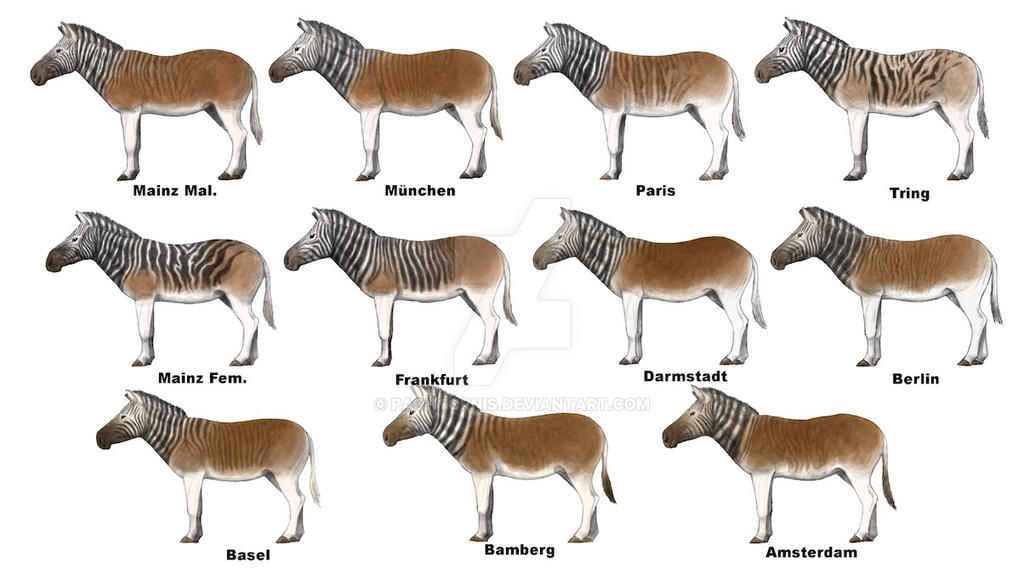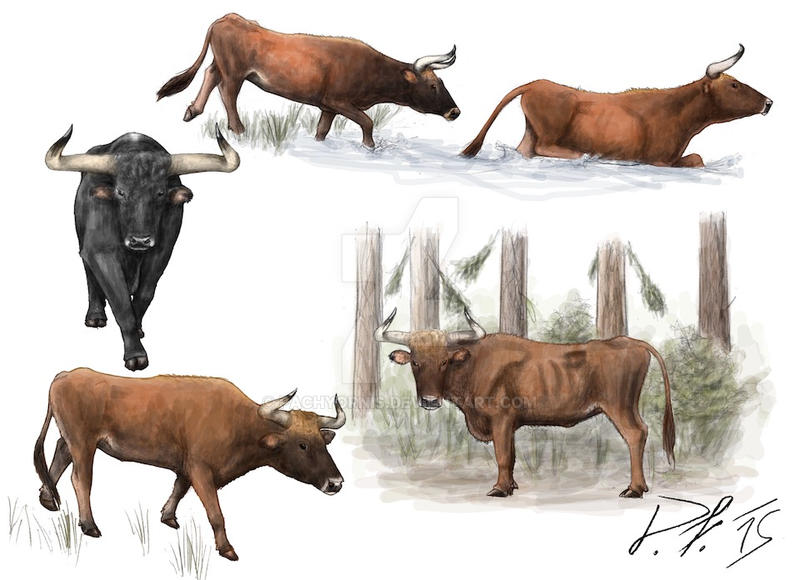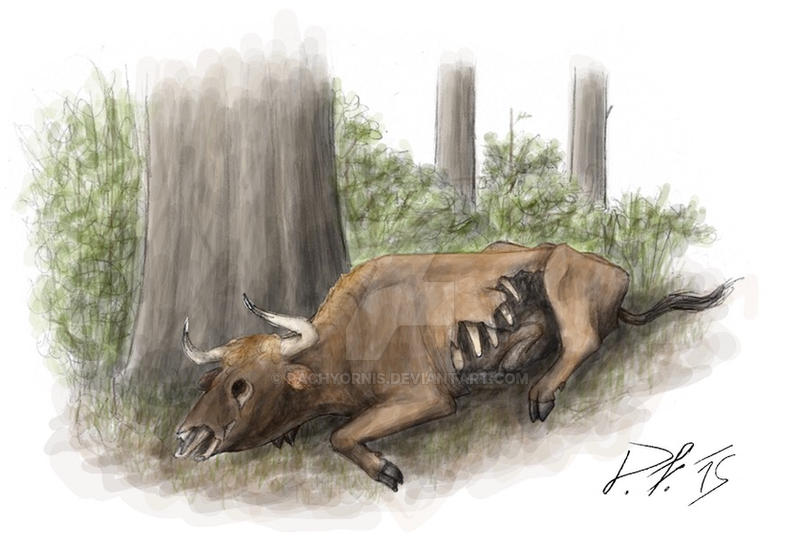The 23 preserved quagga skins tell us that there was quite considerable variation regarding stripe reduction in this animal. This is not only an interesting fact for itself but also of importance for the Quagga Project. So I tried to capture this colour diversity in one picture, so that we can see it at one glance.
I decided only to use the skins as a reference. There are plenty of old drawings depicting quaggas, but most of them are from a time after its extinction. And those that might be contemporaneous are, just as many the others, mostly just copies of the widely used photo of the mare at London zoo (by the way, I decided not to include the London mare, which is identical with the Edinburgh skin, because I already did an illustration of that specimen and it does not differ substantially from the other quagga individuals). The webpage of the QP project provides a nice overview over all preserved skins with background information. A quick google research will result in more pictures of the respective specimen.
However, I did not include all of the skins in my drawing. For the simple reason that many of them do look much alike and I did not want the image to become all too large. Therefore the relation of the individuals with the weaker stripe pattern and the stronger stripe pattern is not exactly the same as in the preserved skins, because the excluded individuals are mostly of the weakly-striped type. So the latter was the prevailing one, probably by far.
While the skins give a very good idea of the colour pattern, telling the exact tone was difficult because none of those is younger than 132 years (today). Therefore, all of them must be bleached today (I consider it very likely that the Berlin specimen is bleached as well, eventhough the QP webpage speculates it is not). So it is not easy to say when stripes were deep black or just dark brown, and if the neck and head region was always black-white or maybe striped in a dark brown and light brown pattern. So I used the hair on the legs as reference, which were probably always white in life. So if the hair of the space between the stripes was the same colour as those on the legs, they probably where white. And for black, I used the colour of the dark stripes on the mane as reference. I had to speculate about the shade of the background colour in the Frankfurt, Tring and Mainz (female) specimen. I am not sure if it really was that light on the trunk. But mostly the skins were sufficient to get an overall idea of the colour. But for the brown regions, it was not easy to tell which tone they had - chestnut, dark brown, orangish? So I had to guess and preferred a chestnut-like colour (note that I use that word in its universal meaning, not its meaning as a horse colour).
It was tempting to arrange the specimen as a kind of colour pannel and therefore suggesting the stripe pattern reflects an ecological cline within the quagga, as it is hypothized by some. But unfortunately, it seems that the actual localities where the animals have been obtained have not been noted or are not known in most cases. That makes it impossible to test this hypothesis, as long as no research has been done to find out the respective origins of the skins. It would be a small sample size anyway.
Doing these drawings confirmed my notion I have done several times already. While the reduced stripe pattern on the trunk of the quagga and the Rau zebras of the QP sometimes looks much alike, the reduction of stripes follows a different pattern on the anterior part of the body. The stripes on neck and face are almost always thicker than the space between them, sometimes more than twice as much. In most of the Rau zebras, the stripes on the neck region seem not to be thicker than in other Burchell's zebras and often have "shaddow stripes" (as some quagga did), which are not counted in the QP's scoring system. The stripes on the head of some Rau zebras are very reduced, creating much white space, while the stripe pattern on a quagga's had is actually to be called intensified.
The way of stripe reduction in Rau zebras resembles that of specimens like Darmstadt, Mainz (male) and Munich. In other cases, such as the Tring specimen, the Rau zebras have a similar pattern but it is not that "squiggely". The stripes of the specimen from Berlin and Amsterdam seem to be numerous but they get smaller and their contours smoother, and their colour continues to merge with the background towards the end of the trunk. Some quaggas, on the other hand, have stripe patterns that I think do not occur neither within Rau zebras or other living Plains zebra populations, such as the Basel and Frankfurt specimen, which have these broad, horizontal and smooth stripes, regularly arranged along the trunk. Other cases, such as the female Mainz specimen or that at Vienna (not included in the drawing) show striping to an extreme extent in a way that I have not seen it in living P. zebras yet. Again in a kind of "squiggled", or irregular somehow.
The explanation for that is simply that the quagga had some unique traits, which would be the result of population genetics in any way if the quagga was just the end of a cline or a separate population. Nothing would hinder new traits to evolve.
I also have the suspicion that the mane of the quagga was a few centimetres shorter than in other P. zebras. It looks like this is the case in all skins. That might be due to preservation, but the photos of the alive mare at London zoo also show an animal with a comparably short mane. Measurements of the mane length in the specimen might provide some insight, it would be interesting to have this suspicion confirmed.
"Breeding-back" aims to restore or immitate extinct animals by selective breeding. This blog provides general information, the facts behind myths and news from various projects.

Saturday, 26 September 2015
Thursday, 24 September 2015
Aurochs illustrations showing their natural behaviour
Since most of my aurochs illustrations are rather technical, I felt like doing some lifelier drawings. I intended to show natural behaviour of wild and domestic cattle that surely was true for the aurochs as well, and also some episodes reported from Jaktorow.
The bull on the lower drawing is a life restoration of the huge Pleistocene skull fragment + horns (here). Aurochs humping domestic cows is a behaviour reported by Schneeberger in Gesner 1602, and also suggested by genetics. Schneeberger also wrote of a cow that he witnessed which was very mangled and he believed it would not survive the next winter. The cow at the lower right of the lower drawing is meant to be an illustration of that individual - I think it is the first time that someone illustrated a particular, once-living aurochs individual that really existed and was physically described in the literature. My drawing of the carcass of the last living aurochs is basically just any dead aurochs cow, on the other hand.
More illustrations of natural and reported behaviours are to come.
And just for fun: Who wants to guess which breed the body shape of the cow at the lower left on the upper drawing is based on? (I tracked it out based on a photo)
The bull on the lower drawing is a life restoration of the huge Pleistocene skull fragment + horns (here). Aurochs humping domestic cows is a behaviour reported by Schneeberger in Gesner 1602, and also suggested by genetics. Schneeberger also wrote of a cow that he witnessed which was very mangled and he believed it would not survive the next winter. The cow at the lower right of the lower drawing is meant to be an illustration of that individual - I think it is the first time that someone illustrated a particular, once-living aurochs individual that really existed and was physically described in the literature. My drawing of the carcass of the last living aurochs is basically just any dead aurochs cow, on the other hand.
More illustrations of natural and reported behaviours are to come.
And just for fun: Who wants to guess which breed the body shape of the cow at the lower left on the upper drawing is based on? (I tracked it out based on a photo)
Tuesday, 22 September 2015
A quagga herd
During the last weeks, my motivation for writing was not that high. But instead, my spent some time doing my artistic activities. Dinosaur models and drawings, which are not quite of interest for that blog, but also some others. Today I want to share a little illustration of a quagga herd in their native environment somewhere in South Africa.
I rarely do life scenaries because I prefer to do my rather technical drawings, therefore the results are not very elaborated. So mostly I leave it to those who are better at it. But this time I tried it again, also because I feel that the quagga is rarely illustrated as a herd animal in its natural enviroment. The coat pattern of these individuals is based on the 23 preserved skins.
A more precise illustration of the coat pattern variation in the quagga population is going to come soon.
I rarely do life scenaries because I prefer to do my rather technical drawings, therefore the results are not very elaborated. So mostly I leave it to those who are better at it. But this time I tried it again, also because I feel that the quagga is rarely illustrated as a herd animal in its natural enviroment. The coat pattern of these individuals is based on the 23 preserved skins.
A more precise illustration of the coat pattern variation in the quagga population is going to come soon.
Tuesday, 15 September 2015
The last of her kind
Due to the lack of time, my latest extensive post has been long ago, I apologize. This time, I want to present a drawing I recently did plus a little bit of background information.
It is an illustration of the last aurochs after its death in 1627.
As frequent readers of my blog will know, the Polish forest of Jaktorów was (most likely*) the last refuge for the aurochs on earth. They were guarded, forstered and also hunted. In the year 1557 the herd numbered probably about 50 animals. But habitat loss, lack of nourishment, poaching and cattle diseases made effective conservation increasingly difficult, as did the severely cold winters**. So their number shrunk to 38 in 1567, then 24 in 1599 and subsequently four in 1602. By 1620, the last male aurochs had died (One of this bull's horns was ornamented and preserved and is now housed at Stockholm, here). Now the species was eventually doomed to extinction.
* There is the possibility that a game park at Zamoyski kept aurochs around 1600, based on a written document.
** I say it would be wrong to claim that climate changes, which had undoubtedly happened back this time ("Little Ice Age") drove the aurochs to extinction just as man did. I see no reason why a healthy aurochs population with a sufficient range would not have succombed such a cold phase, which surely was not the only one this species ever experienced. But it certainly was a triggering factor in the extinction of this - because of human influence - highly vulnerable population.
The last aurochs was a female that died in 1627. It was not, as widely believed, poached or shot by hunters, but it seems to have died a natural death. Perhaps because of old age, but there is room for many possibilities. There is no information on what happened with its body or horns - neither was her skull defleshed and is now housed at stockholm, nor is her horn that of the last bull from 1620 linked above, as some sources on the web claim. Maybe it was just left to decay in the field as I illustrated.
So we can imagine how this old, tired and probably mangled cow wandered around somewhere in the light forests of Jaktorow. She had not seen a conspecific for seven years now, and we do not know her exact age and if she ever calved, but she managed not to starve, not to get killed by the wolves, not to die of some disease, not to get poached and was spared from being hunted down for all these years. Now, perhaps during a cold winter, she is looking for some shelter between old oak trees to retreat from the cold. She lies down and closes her eyes forever, and one more species vanished from our planet.
Perhaps it was like this when the last aurochs died, or perhaps not.
Literature
Cis van Vuure (2005): Retracing the Aurochs: History, Morphology and Ecology of an extinct wild ox.
It is an illustration of the last aurochs after its death in 1627.
As frequent readers of my blog will know, the Polish forest of Jaktorów was (most likely*) the last refuge for the aurochs on earth. They were guarded, forstered and also hunted. In the year 1557 the herd numbered probably about 50 animals. But habitat loss, lack of nourishment, poaching and cattle diseases made effective conservation increasingly difficult, as did the severely cold winters**. So their number shrunk to 38 in 1567, then 24 in 1599 and subsequently four in 1602. By 1620, the last male aurochs had died (One of this bull's horns was ornamented and preserved and is now housed at Stockholm, here). Now the species was eventually doomed to extinction.
* There is the possibility that a game park at Zamoyski kept aurochs around 1600, based on a written document.
** I say it would be wrong to claim that climate changes, which had undoubtedly happened back this time ("Little Ice Age") drove the aurochs to extinction just as man did. I see no reason why a healthy aurochs population with a sufficient range would not have succombed such a cold phase, which surely was not the only one this species ever experienced. But it certainly was a triggering factor in the extinction of this - because of human influence - highly vulnerable population.
The last aurochs was a female that died in 1627. It was not, as widely believed, poached or shot by hunters, but it seems to have died a natural death. Perhaps because of old age, but there is room for many possibilities. There is no information on what happened with its body or horns - neither was her skull defleshed and is now housed at stockholm, nor is her horn that of the last bull from 1620 linked above, as some sources on the web claim. Maybe it was just left to decay in the field as I illustrated.
So we can imagine how this old, tired and probably mangled cow wandered around somewhere in the light forests of Jaktorow. She had not seen a conspecific for seven years now, and we do not know her exact age and if she ever calved, but she managed not to starve, not to get killed by the wolves, not to die of some disease, not to get poached and was spared from being hunted down for all these years. Now, perhaps during a cold winter, she is looking for some shelter between old oak trees to retreat from the cold. She lies down and closes her eyes forever, and one more species vanished from our planet.
Perhaps it was like this when the last aurochs died, or perhaps not.
Literature
Cis van Vuure (2005): Retracing the Aurochs: History, Morphology and Ecology of an extinct wild ox.
Subscribe to:
Posts (Atom)




